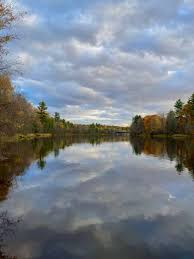Dear George,
One of my
favorite places these days is the Oakleaf Trail at Miami Whitewater
Forest. There’s a path at the south edge of the trail that leads down to
a bench at the edge of the pond, and it’s a peaceful place to contemplate
nature and think about life’s quirkiness. Fish nip at the water’s
surface; frogs jump off the bank as people approach; ducks swim and feed; you
might see a turtle if you’re lucky; and dragonflies flit here and
there. Watching the
dragonflies takes me back to childhood on the Menominee River where they would
hover around our rowboat and sometimes land and rest momentarily on our
shoulders or arms. It always made us nervous, but they never bit. Dragonflies are certainly among the
most majestic insects we encounter. I realized how little I really know
about them, so I asked Google a bunch of questions. Here’s are some of
the highlights.
Griffenflies
(artist’s rendition)
How long
have dragonflies inhabited the earth? Longer than we can imagine. Griffenflies, the
giant precursors of today’s dragonflies, existed over 300 million years ago in
the Carboniferous period. With three-foot wingspans, they were the
largest insects in history. (1, 5) [note: #’s in parentheses refer to
references at end]
How many
different species of dragonflies are there? There are about 5,900 different species
of dragonflies in the world today, including 450 species in the U.S. and 114 in
the state of Michigan alone. Dragonflies inhabit all the world’s
continents except Antartica. (4, 7, 12)
Where
should you look for dragonflies? They usually live around water because their larvae, known as
“nymphs” or “naiads”, are aquatic. (12)
How big do
dragonflies get?
Dragonflies range in size from one inch to six inches or more. There are
dragonflies in Costa Rica that have wingspans of 7.5 inches. (6, 7)
What do
dragonflies eat?
Dragonflies eat mosquitoes, as well as ants, bees, wasps, flies, and even an occasional
butterfly. A single dragonfly can eat several hundred mosquitoes a
day. For this reason alone, dragonflies are among humans’ best
friends. (11, 12)
Dragonfly
eyes
Can
dragonflies see well?
Dragonflies have extraordinary vision. Each of their compound eyes has up
to 30,000 lenses, and they can see in many directions at once. Their eyes
make up almost their entire head. They also can see a wider spectrum of
colors than people can. (1, 11)
How fast
do dragonflies fly?
Dragonflies are remarkable fliers. They can move each of their four wings
independently, and they can fly in any of six directions: up, down, forward,
backward, and side to side. Large dragonflies are among the fastest
insects in the world. They cruise at about 10 m.p.h., though they can
reach speeds above 30 m.p.h. One biologist reports measuring a dragonfly
in the field flying at 60 m.p.h. Scientists at Harvard have photographed
dragonflies taking flight, catching their prey, and returning to a perch, all
within one to 1.5 seconds. Dragonfly flight is so extraordinary that
engineers have envisioned designing flying robots patterned after them.
(11, 12)
Dragonflies
in the wheel formation
How do
dragonflies mate?
First the male searches for an appropriate partner. Since there are so
many species, he has to identify a female of his own species from her flight
style, coloring, patterns, and size. While they’re both in flight, the
male grabs the female around her thorax with his legs and clasps her by the
neck. As they’re flying in tandem, she bends her abdomen forward, and he
connects his private parts to hers. This is known as the wheel formation
because the couple forms a closed, heart-shaped circle. Some pairs
consummate mating in flight, while others retire to a nearby perch. After
mating, many males then guard their partners by chasing off and/or fighting
with approaching males. (2)
Do
dragonflies lay eggs?
Females lay eggs in or near water, often on plants. A single female may
lay hundreds or even thousands of eggs at one time. The eggs usually
hatch in two to three weeks. (3)
A dragonfly
naiad
Do
dragonflies fly as soon as they’re born? No, definitely
not. In their initial larval
stage, dragonfly naiads live underwater for two to three years. This is
the great majority of the dragonfly’s life span. Naiads breathe through
gills in their rectum and can propel themselves by expelling water from their
rear ends. They have extendable jaws that enable them to catch mosquito larvae
and even tadpoles and minnows. They shed their skins up to ten or fifteen
times during their larval period. (5, 12)
How long
do adult dragonflies live? After they’ve shed their final larval
skin and emerged from the naiad stage, dragonflies can live for five to six
months. (12)
Do
dragonflies migrate?
A number of dragonfly species migrate in response to cold weather.
Biologists have documented dragonflies called global skimmers making an 11,000
trip between India and Africa.
Migrating dragonflies can live longer than those who stay put. (1)
Can
dragonflies hurt human beings? Adult dragonflies are harmless and don’t sting or bite
people. Naiads, on the other hand, can deliver painful stings to people
(though the stings are harmless). (6)
Birds eat
dragonflies
Who are
dragonflies’ predators? It’s perilous to be a dragonfly -- they have a lot of
enemies who like to eat them. These include fish, birds, lizards, frogs,
spiders, water bugs, and even larger dragonflies. (12) Young, newly
emerged dragonflies are particularly vulnerable, and it’s estimated that about
90% are eaten by birds and other predators. (1)
Do people
eat dragonflies?
Dragonflies are a food source in some parts of the world. In Indonesia
they are caught on poles and fried in oil as a delicacy. (12)
Where did
dragonflies get their name? Nobody knows for sure. However, an author named Eden
Sarot (1958) speculated that it came from an ancient Romanian folktale in which
the Devil turned a beautiful horse into a giant insect. Sarot's hunch is
that, because "drac" is the Romanian word for dragon as well as
Devil, "Devil's fly" eventually became transformed in the English
language into "Dragon fly." (13)
Red Dragonfly
and Locust (Metropolitan Museum of Art) (8)
How are
dragonflies viewed in various cultures? In Japan dragonflies are symbols of courage, strength,
and happiness. In Europe they have been seen more often as
sinister. The Norwegian name for dragonflies means “eye-poker”; the Portugese
name, “eye-snatcher”. A folk belief in the southern U.S. is that
dragonflies are “snake doctors” who follow snakes around and stitch them back
together when they get injured. (12)
All in all,
dragonflies are astonishing. Given all these facts, I don’t think I’ll
ever view them quite the same. Now I’m eager to get back to the pond at
Miami Whitewater and see how many varieties I can spot.
Love,
Dave
SOURCES: (1) www.about.com,
“10 Fascinating Facts About Dragonflies”; (2) www.about.com, “How
dragonflies mate”; (3) www.answers.yahoo.com, “How many offsrpoimg do
dragonflies produce at one time?”; (4) www.biokids.umich.edu,
“Anisoptera”; 5) www.bugfacts.net,
“Dragonfly”; (6) www.dragonflies.org, “The
study of dragonflies”; (7) www.dragonfly-site.com,
“Facts and myths about dragonflies”; (8) www.haikuproject.wordpress.com,
“Dragonfly dreams”; (9) www.listverse.com, “10
surprisingly brutal facts about dragonflies”; (10) www.orkin.com, “Dragonflies”; (11) www.smithsonianmag.com, “14 fun facts about
dragonflies”; (12) www.wikipedia.org,
“Dragonfly”; (13) www.wiki.answers.com,
"How did dragonflies get their name"; (14) www.wiki.answers.com, “Can humans eat dragon
flies?”; (15) www.wildernessclassroom.com,
“Green Darner Dragonfly”
G-mail Comments
-Phyllis S-S
(8-20): Dear Dave,,
This was wonderful information. I used to adore watching dragonflies when
I went fishing with my father.
Enjoyed the bibliography.
Phyllis
-Linda C (8-1): Thanks for all the interesting info.
They are fascinating and always remind me of a fairy word… Wish we could all get together
sometime. Love Linda
-Gayle C-L
(7-31): David, That was a cool read!.... Amazing, 5900
species. Here I thought there was only one! Thank you for that!... Hope you get to see many of the
varieties! Love
G :)

























































































































































No comments:
Post a Comment